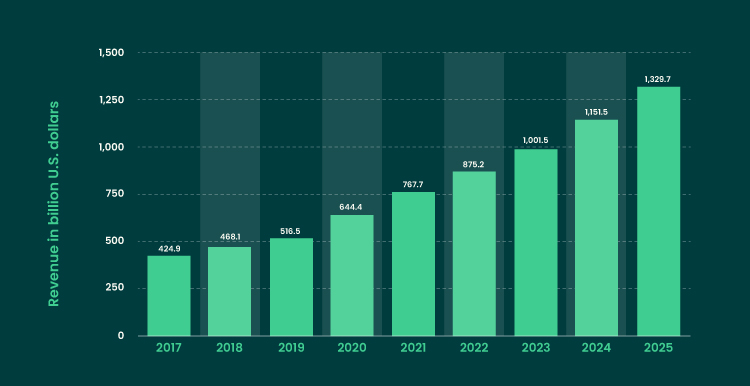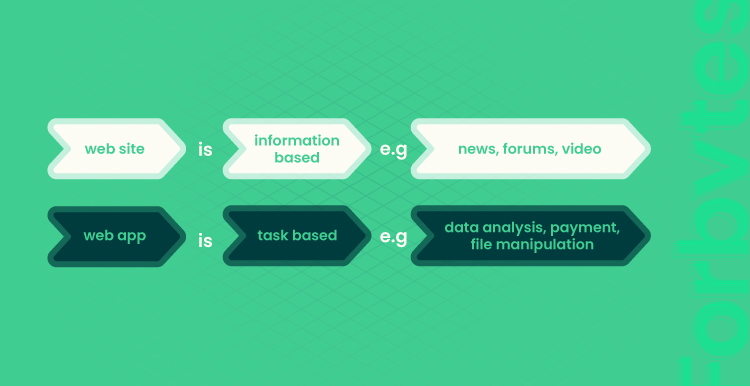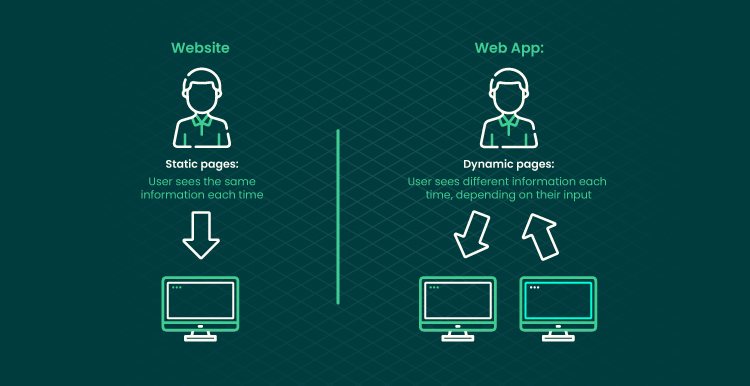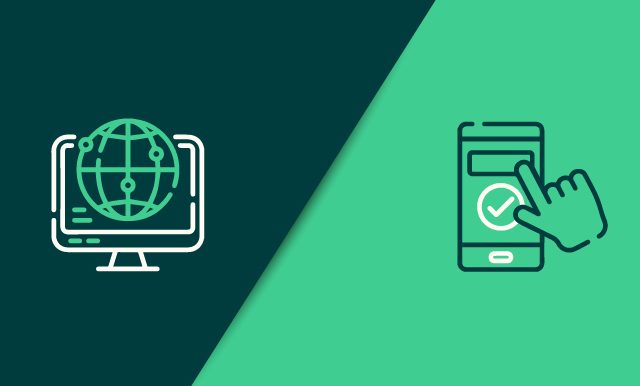Let’s talk about another dilemma the modern tech world makes us solve – how to distinguish between web applications and websites? Online business owners may face a challenge: choosing between a web application and a website for their business needs. At the same time, the online trading industry is developing rapidly. According to the Statista forecast, by 2025, the total volume of online sales will cross the point of $1.3 trillion.

Mostly, people don’t distinguish between websites and web applications. They even don’t think about that. Moreover, the end-users don’t even think about what they are using, a website or a web application. They just enter the URL in the search bar and expect the necessary result.
But the difference is obvious for those who are about to start their online business and for the team of developers. And this shapes the list of requirements of the project. To make the right choice, it’s worth knowing more about both of them.
So, what makes them different? Disclaimer: all web applications are websites but not all websites are web apps.
What Is a Good Website?
A website is a collection of well-structured web pages arranged with internal links on the same domain. Displaying information to visitors, as blogs or news portals do, is the main goal. If you are looking for an effective way to showcase your list of products or services, a website is definitely the right solution. It will help you in:
- making basic info about the company easy to reach out;
- generating new leads;
- finding new clients and sales growth;
- providing client-oriented content.
In most cases, users don’t interact with the web page because of the lack of extensive features. Its functionality is limited to registration and search functions. Users can only view the content (text, pictures, videos, etc.) and can’t take any actions. Popular types of websites may include but are not limited to landing pages, blogs, portfolios, social media websites, educational websites, etc.
Website development would require someone with knowledge of HTML, CSS, and maybe a little bit of JavaScript.
Website cons
- limited functionality;
- risk of spam is caused by having no possibility to filter emails received through premade contact forms;
- difficulties in changing info as there is no possibility of automatic updates. To make changes on regular basis you should schedule them.
What Is a Good Web Application?
A website application is a software program that is stored on the server and is run through web pages. In the web app, the browser serves as the user interface. Unlike mobile or desktop applications, it doesn’t have to be downloaded and installed on the user’s device. They are designed to be responsive and look great on all types of devices.
The primary purpose of a web application is to interact with users and respond to their various requests. Web-based applications present some information too, but they can also process data received from the users. Netflix, Google docs, Trello, Gmail, and Wikipedia may serve as examples of the most known and trusted web applications.
Unlike websites, web apps are more customized, thus more difficult to create. Web applications are created using a combination of programming languages and web application frameworks. To develop a web application, you’ll need a development team with the skills of HTML, CSS & JavaScript, PHP, Python, and other frameworks like Django, CakePHP, etc.
Web applications cons
- depending on the chosen solution and complexity of the project, creating a web application is more costly;
- web apps require more time for development compared to the time needed for creating an ordinary, static website;
- more efforts are required – you would need both front-end and back-end developers.
Web application types
There are types of web applications that you may already know: (1) web portals, (2) online stores, and (3) social networking apps.
- The term web portal, most simply put, is a kind of a website. The main idea is in accessing information collected from various sources at a single point. Web portals offer a new approach to communication and information quality, advancements in interaction, and targeting. It’s worth mentioning, that they are highly complex in development and special frameworks are applied (AngularJS, Ruby on Rails, ReactJS, etc);
- An online store is an integral part of online shopping. Its main features are offering products or services for sale and accepting online payments. Visitors are able to search requested items, brands, models, etc;
- Instagram, Facebook, WeChat, and other social networking apps initially started as web applications and are the most known web apps. Nowadays, these are used mostly as mobile applications.
Web applications have alternatives such as mobile applications and installed applications.
Web App vs. Website: Basic Distinctions
To be more precise, let’s talk about the main differences between websites and web-based applications.
Reasons
Websites are created for users to consume content and understand the service or product offered. To some extent, a website can be called an “online business card”. And the main distinction between a website and a web application lies here, in functionality. In addition to providing content, web applications also encourage interaction with users.

Interactions
End-users are only viewers of content and no interaction is supposed when it goes to websites. Web applications are interactive. End-users are highly engaged and can manipulate data.
Integration
Integration is the process of combining simple components into one complex one. Developers can integrate web applications and sites with programs, including ERP or CRM. However, in most cases, integration occurs with web applications because their functions often require additional information from third-party systems. The most popular type of integration offered for eCommerce is the integration of a web app with a CRM (customer relationship management) system. It helps store customer data and order information and improves sales team performance.
Thanks to the integration, information about web application users is automatically collected and stored in the CRM system. Such integration allows the sales team to learn more about customer behavior and their preferences when buying goods and work more effectively with negative feedback. This is very beneficial for online business owners, as all changes in customer information are automatically reflected in the CRM. This way of interacting with customer information can increase sales and improve the online store.
Websites use basic CRM to curate customized content for visitors. Web applications use extensive CRM analytics to track user behavior, purchase history, and interest in the product in general.
Authentication
Unlike websites, web applications require authentication. That is entering login ID and password for access. People don’t feel comfortable sharing personal data, and here come security issues. The chance for a website to be hacked is almost eliminated. Web applications need data protection measures. If an application provides a payment function, the risks of crack grow.
Most information sites use authorization. In some cases, this is used to provide more features that are not available to unauthorized users. If unregistered users can only view articles, registered users can leave comments, share articles on social networks, etc. This is also a great solution for blocking spam. Therefore, authorization is required for both websites and web applications. At the same time, web applications need it for security.
Development
A website is considered to be easier to build in terms of development. A web-based application is more puzzling to be created because of its more diverse functions, variety of users, and security issues.
Deployment
Code deployment is not necessary when changes are introduced to a website. And it works differently for a web application. You’ll have to re-deploy after each small change.
Personalization
Websites don’t require personalization, while web apps prove to be more effective when having access to users’ cameras, etc.
Availability
When speaking about online availability, web apps require an Internet connection. Websites offer access to content without connection.

Time and cost
Websites take less time and cost to develop. A website development process would usually take from two weeks to one month. It depends on whether it’s static or dynamic. Working on application development would be more costly. Especially, if the project requires a cross-platform representation. The whole project consists of two phases: MVP and scaling. Most of the time is spent on developing functions based on the users’ demands. It can take even years.
Errors
The risk of errors when developing a website is lower compared to developing a web app.
How Web Apps Help Improve Business Development
Deploying a web-based application can bring the company brand to a new level as it’s made explicitly to your business needs. It can boost sales and marketing as well as business functionality.
Optimized Efficiency
With web-based applications, you can optimize processes or base future strategies on client data – custom web apps help you deliver as per client expectations.
Access 24/7
With web apps, your company will be presented online 24/7 365 days per year offering your clients moment access from practically any device. Raise up your credibility with support from web hosting service providers.
Security
Personal data is sensitive. Storing on hard disks and other devices is risky. With web apps, you can store your data in the cloud and access them anytime.
Scalability
That’s one of the most important factors to consider when you start your business. As market demands shift, business functionalities should change too. Web apps offer easy scaling capacities so that you can arrange your services makeover anytime. Moreover, web apps are easy to expand in the future.
Basic 5 Factors to Remember When Developing a Website or a Web-Based Application
- The popularity of mobile devices as a means of surfing the Internet is increasing. Roughly 52% of the global traffic is generated by smartphones. Be sure to make your website or app mobile responsive and easy to navigate. Don’t expect users to be loyal.
- Advance your web product for verbal search queries. Voice search was introduced by Google in 2011 and had little recognition by users at the time. Now, 41% of adults use technology at least once a day. Among the most popular online searches are music, weather forecast, news, etc. Put a good SEO strategy to the forefront of search marketing.
- According to the Google page load time study, 1-5 seconds of load time increases the bounce rate probability by 90%. Less than 3 seconds is how long the end-users are ready to wait and stay. Fast pages are more attractive. Speed is the core.
- Arrange information friendly for comprehension. Users would like to look through and skip some content instead of reading every word.
- Avoid unnecessary elements. Make the design of your site or web application clean. Minimalism continues to be in trend. Come up to developing with this on your mind.
Conclusion
While having a website to showcase your business is almost a must in 2022, launching a web application is a more tricky project. Though websites and web applications may seem similar, they are completely different. The baseline that differs them is that web applications keep users engaged with the site.
When comparing a website vs. a web application to choose what suits you best, you should start from the needs of your business. If your company needs a website, you can hire a small eCommerce outsourcing company. Such teams can handle website development and individual design, where you can share information about your company. But if you need to add a custom module to your site or develop it from scratch, you have to find a team that specializes in developing web applications. Moreover, pay attention to the web applications that the team already has in its portfolio.
Are you still hesitating about what you need? Fill out the form and leverage the Forbytes team to accomplish newly emerged business tasks. We’d like to discuss your ideas and find perfectly suited solutions together.

Our Engineers
Can Help
Are you ready to discover all benefits of running a business in the digital era?

Our Engineers
Can Help
Are you ready to discover all benefits of running a business in the digital era?







